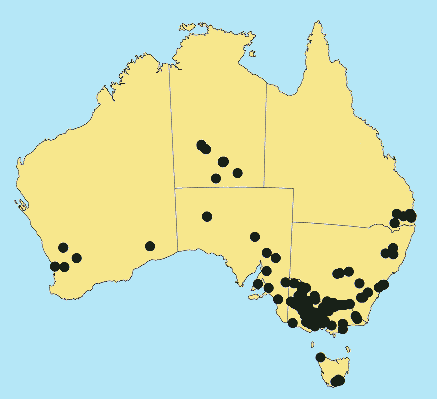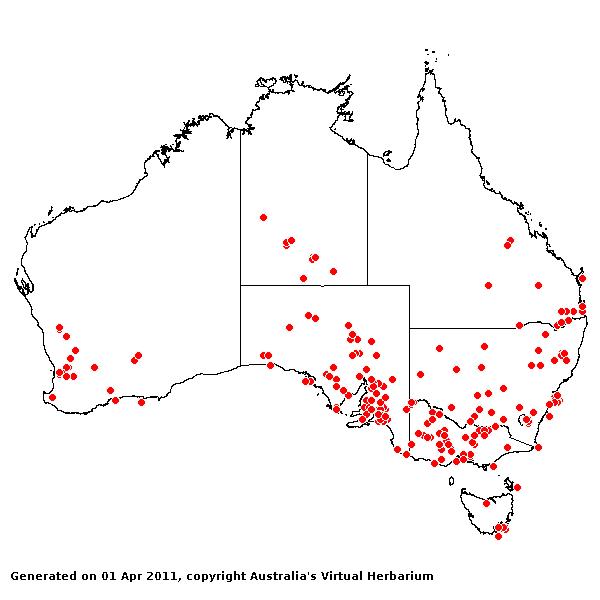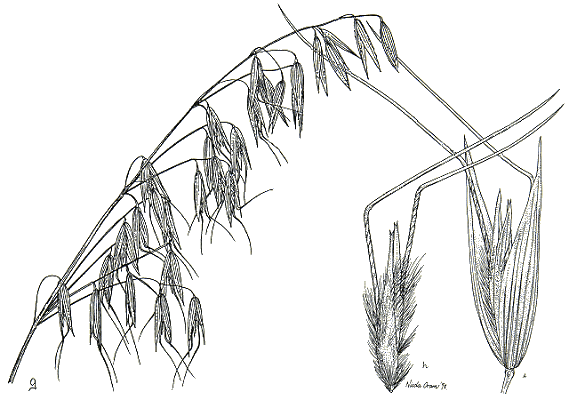Avena fatua* L. Sp. Pl.
80 (1753).
Classification. (GPWG 2001) : Subfamily Pooideae.
Tribe Poeae.
Type of Basionym or
Protologue Information: Herb. Linn. 95/9 (LINN lecto).
Key references
(books and floras): [1878] G.Bentham, Flora Australiensis 7 (588),
[1952] C.A.Gardner, Flora of Western Australia 1 Gramineae (37),
[1981] M.Lazarides in J.Jessop (ed)., Flora of Central Australia (434),
[2002] D.Sharp & B.K.Simon, AusGrass, Grasses of Australia, [2006]
J.Jessop, G.R.M.Dashorst, F.M.James, Grasses of South Australia (208),
[2008] S.W.L.Jacobs, R.D.B.Walley & D.J.B.Wheeler, Grasses of New South
Wales (162), [2009] A.Wilson (ed.). Flora of Australia, Vol 44A. Poaceae
2 (126).
Illustrations:
[1952] C.A.Gardner, Flora of Western Australia 1 Gramineae (38,
Pl. 9), [1983] J.C.Tothill & J.B.Hacker, Grasses of Southern Queensland
(122), [2006] J.Jessop, G.R.M.Dashorst, F.M.James, Grasses of South
Australia (208, Fig. 154), [1984]
N.T.Burbidge. rev. S.W.L.Jacobs, Australian Grasses (71), [2008] S.W.L.Jacobs, R.D.B.Whalley &
D.J.B.Wheeler, Grasses of New South Wales, 4th edn (162), [2009].
A.Wilson (ed.), Flora of Australia 44A: Poaceae 2 (162, Fig.24).
Habit. Annual.
Culms erect or geniculately ascending, 30–125(–160) cm tall, 3–5 -noded. Leaves
mostly basal or basal and cauline or cauline. Ligule an eciliate membrane, 4–6
mm long, abaxially hairy. Leaf-blades 10–45 cm long, 3–15 mm wide. Leaf-blade
surface scaberulous.
Inflorescence.
Inflorescence compound, a panicle. Panicle pyramidal, 7–40 cm long, 5–20 cm
wide.
Spikelets.
Spikelets pedicelled. Fertile spikelets 1 or more flowered, with 1 fertile
floret (2–3), comprising 2–3 fertile floret(s), with a barren rachilla extension,
cuneate, laterally compressed, 18–30 mm long.
Glumes. Glumes
similar, thinner than fertile lemma. Lower glume lanceolate, membranous,
without keels, 7–11 -nerved. Upper glume lanceolate, 18–30 mm long, membranous,
without keels, 7–11 -nerved.
Florets. Fertile
lemma 14–22 mm long, without keel, 7–9 -nerved. Lemma surface indumented. Lemma
apex dentate, awned, 1 -awned. Median (principal) awn dorsal, 25–48 mm long
overall, with a twisted column. Palea apex entire or dentate. Anthers 3. Grain
6–8 mm long.
Continental
Distribution: Europe, Africa, Temperate Asia, Tropical Asia, Australasia,
Pacific, North America, South America, and Antarctica.
Australian
Distribution: Western Australia, Northern Territory, South Australia,
Queensland, New South Wales, Victoria, Tasmania.
Western Australia:
Austin. Irwin, Drummond, Avon. Northern Territory: Central Australia
North, Central Australia South. South Australia: Lake Eyre, Nullabor,
Gairdner-Torrens Basin, Flinders Ranges, Eastern, Eyre Peninsula, Northern
Lofty, Yorke Peninsula, Southern Lofty, South-eastern. Queensland:
Darling Downs, Maranoa, Moreton, Warrego, Wide Bay. New South Wales:
Central Coast, South Coast, Southern Tablelands, North-Western Slopes,
South-Western Slopes, North-Western Plains, South-Western Plains, North Far
Western Plains. Victoria: East Gippsland, Eastern Highlands, Gippsland
Highlands, Gippsland Plain, Grampians, Lowan Mallee, Midlands, Murray Mallee,
Otway Plain, Otway Range, Wilsons Promontory, Riverina, Snowfields, Volcanic
Plain, Wannon, Wimmera. Tasmania: North West, East Coast, South West.
Notes.
Introduced. All Australian states and territories. Probably native to the
Mediterranean but widely naturalized. Common weed of disturbed ground and
cereal crops. Flowers July-Dec. Fruits ?-Dec.




